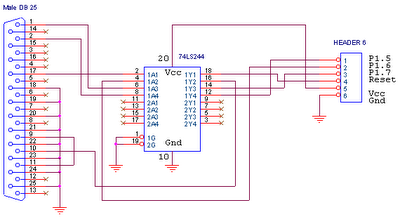
this circuit is isp flash programmer

This circuit is designed for use with ATMEL Microcontroller ICs, specifically the AT89Sxx and ATMEGA series. It operates using the MISO, MOSI, SCK, and RESET signals.
This circuit serves as a foundational interface for programming and communication with ATMEL microcontrollers, particularly the AT89Sxx and ATMEGA series. The primary signals involved in this circuit are MISO (Master In Slave Out), MOSI (Master Out Slave In), SCK (Serial Clock), and RESET, which are essential for synchronous serial communication.
The MISO line is used to transmit data from the microcontroller to the master device, while the MOSI line carries data from the master to the microcontroller. The SCK line provides the clock signal that synchronizes data transmission between the master and the microcontroller. The RESET line is crucial for initializing the microcontroller, ensuring it starts executing code from the beginning of its memory.
In practical applications, this circuit can be implemented for various purposes, including programming the microcontroller during development or enabling communication between the microcontroller and other devices in an embedded system. The circuit may include pull-up resistors on the RESET line to ensure reliable operation, as well as decoupling capacitors to stabilize the power supply voltage.
Overall, this circuit is integral to leveraging the capabilities of ATMEL microcontrollers, facilitating both development and operational functionality in electronic systems.This circuit is used on the ATMEL Microcontroller IC. However, the circuit is used for Microcontroller AT89Sxx. and ATMEGA xxx if you know about MISO, MOSI, SCK AND RESET 🔗 External reference
This circuit serves as a foundational interface for programming and communication with ATMEL microcontrollers, particularly the AT89Sxx and ATMEGA series. The primary signals involved in this circuit are MISO (Master In Slave Out), MOSI (Master Out Slave In), SCK (Serial Clock), and RESET, which are essential for synchronous serial communication.
The MISO line is used to transmit data from the microcontroller to the master device, while the MOSI line carries data from the master to the microcontroller. The SCK line provides the clock signal that synchronizes data transmission between the master and the microcontroller. The RESET line is crucial for initializing the microcontroller, ensuring it starts executing code from the beginning of its memory.
In practical applications, this circuit can be implemented for various purposes, including programming the microcontroller during development or enabling communication between the microcontroller and other devices in an embedded system. The circuit may include pull-up resistors on the RESET line to ensure reliable operation, as well as decoupling capacitors to stabilize the power supply voltage.
Overall, this circuit is integral to leveraging the capabilities of ATMEL microcontrollers, facilitating both development and operational functionality in electronic systems.This circuit is used on the ATMEL Microcontroller IC. However, the circuit is used for Microcontroller AT89Sxx. and ATMEGA xxx if you know about MISO, MOSI, SCK AND RESET 🔗 External reference
Warning: include(partials/cookie-banner.php): Failed to open stream: Permission denied in /var/www/html/nextgr/view-circuit.php on line 713
Warning: include(): Failed opening 'partials/cookie-banner.php' for inclusion (include_path='.:/usr/share/php') in /var/www/html/nextgr/view-circuit.php on line 713





